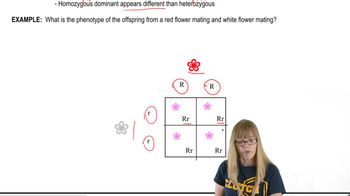Table of contents
- 1. Introduction to Genetics51m
- 2. Mendel's Laws of Inheritance3h 37m
- 3. Extensions to Mendelian Inheritance2h 41m
- 4. Genetic Mapping and Linkage2h 28m
- 5. Genetics of Bacteria and Viruses1h 21m
- 6. Chromosomal Variation1h 48m
- 7. DNA and Chromosome Structure56m
- 8. DNA Replication1h 10m
- 9. Mitosis and Meiosis1h 34m
- 10. Transcription1h 0m
- 11. Translation58m
- 12. Gene Regulation in Prokaryotes1h 19m
- 13. Gene Regulation in Eukaryotes44m
- 14. Genetic Control of Development44m
- 15. Genomes and Genomics1h 50m
- 16. Transposable Elements47m
- 17. Mutation, Repair, and Recombination1h 6m
- 18. Molecular Genetic Tools19m
- 19. Cancer Genetics29m
- 20. Quantitative Genetics1h 26m
- 21. Population Genetics50m
- 22. Evolutionary Genetics29m
2. Mendel's Laws of Inheritance
Dihybrid Cross
Problem 46b
Textbook Question
Alleles of the IGF-1 gene in dogs, encoding insulin-like growth factor, largely determine whether a domestic dog will be large or small. Dogs with an ancestral dominant allele are large, whereas dogs homozygous for the mutant recessive allele are small. Chondrodysplasia, a short-legged phenotype (as in dachshunds and basset hounds), is caused by a dominant gain-of-function allele of the FGF4 gene. The MSTN gene encodes myostatin, a regulator of muscle development. Dogs with a dominant ancestral allele of the MTSN gene have normal muscle development, while dogs homozygous for recessive mutants in the MTSN gene are 'double muscled' and have trouble running quickly. However, dogs heterozygous for the mutant allele run faster than either of the homozygotes.
You breed a pure-breeding small basset hound of normal musculature with a pure-breeding 'bully' whippet, a double-muscled large dog with normal legs.
What are the genotypes and phenotypes of the F₁ puppies?
 Verified step by step guidance
Verified step by step guidance1
Identify the genotypes of the parent dogs based on their phenotypes.
Determine the genotype of the small basset hound: homozygous recessive for IGF-1, heterozygous for FGF4, and homozygous dominant for MSTN.
Determine the genotype of the 'bully' whippet: homozygous dominant for IGF-1, homozygous recessive for FGF4, and homozygous recessive for MSTN.
Perform a Punnett square analysis for each gene to determine the possible genotypes of the F₁ puppies.
Combine the results to predict the phenotypes of the F₁ puppies based on their genotypes.
 Verified video answer for a similar problem:
Verified video answer for a similar problem:This video solution was recommended by our tutors as helpful for the problem above
Video duration:
3mPlay a video:
Was this helpful?
Key Concepts
Here are the essential concepts you must grasp in order to answer the question correctly.
Alleles and Genotypes
Alleles are different versions of a gene that can exist at a specific locus on a chromosome. In this context, the dominant and recessive alleles of the IGF-1 and MSTN genes determine the size and muscle development of dogs. The genotype refers to the genetic makeup of an organism, which can be homozygous (two identical alleles) or heterozygous (two different alleles). Understanding these terms is crucial for predicting the traits of the F₁ puppies.
Recommended video:
Guided course

New Alleles and Migration
Dominant and Recessive Traits
Dominant traits are expressed in the phenotype even when only one copy of the allele is present, while recessive traits require two copies to be expressed. In the case of the IGF-1 gene, the dominant allele results in a large phenotype, whereas the recessive allele leads to a small phenotype. This concept is essential for determining the expected phenotypes of the offspring based on the parental genotypes.
Recommended video:
Guided course

Variations on Dominance
Phenotypic Ratios in Offspring
Phenotypic ratios describe the expected distribution of different traits in the offspring resulting from a genetic cross. In this scenario, the cross between a small basset hound (homozygous recessive for size) and a large bully whippet (homozygous dominant for size) will yield F₁ puppies that are heterozygous for the IGF-1 gene, resulting in a uniform phenotype of large dogs. Understanding how to calculate these ratios is key to predicting the traits of the F₁ generation.
Recommended video:
Guided course

Mutations and Phenotypes
Related Videos
Related Practice





